Technomyrmex mayri
| Technomyrmex mayri | |
|---|---|

| |
| Scientific classification | |
| Kingdom: | Animalia |
| Phylum: | Arthropoda |
| Class: | Insecta |
| Order: | Hymenoptera |
| Family: | Formicidae |
| Subfamily: | Dolichoderinae |
| Genus: | Technomyrmex |
| Species: | T. mayri |
| Binomial name | |
| Technomyrmex mayri Forel, 1891 | |
T. mayri nests terrestrially in and under rotten wood. It forages through the leaf litter and in fallen twigs and timber and has been collected from pitfall traps, but it also forages extensively on low vegetation and may nest in dead twigs above the ground. Worker-queen intercastes are present, as well as alate queens. (Bolton 2007)
Identification
Bolton (2007) - A member of the T. pallipes complex in the Technomyrmex albipes group. Superficially mayri resembles a larger and more slender version of Technomyrmex difficilis, but is easily distinguished by the structure of the propodeum. In difficilis the length of the propodeal dorsum in profile is always much less than the depth of the declivity to the spiracle and marginal setae arise from the declivity above the level of the spiracle. By contrast, in mayri the length of the propodeal dorsum in profile is at least equal to the depth of the declivity to the spiracle, and may be more; marginal setae arise from the declivity directly behind the spiracle or even slightly below it, but none arise above it. Workers of mayri tend to be larger than those of difficilis and have longer scapes and a more elongated, narrow mesosoma, compare the above dimensions of mayri with those of difficilis: HL 0.57 - 0.65, HW 0.52 - 0.61, SI 95 - 105, DTI 127 - 135. Finally. The metathoracic spiracles in difficilis abut, or very nearly abut, the metanotal groove in dorsal view, whereas in mayri the spiracles are usually noticably anterior to the metanotal groove. See also the notes under difficilis.
The setae on the propodeal declivity seem particularly prone to loss by abrasion in this species. Sometimes their pits can be seen, particularly in specimens where full adult colour has not been attained, but in fully coloured specimens the pits are usually not apparent.
Keys including this Species
Distribution
Latitudinal Distribution Pattern
Latitudinal Range: -19.006727° to -19.006727°.
| North Temperate |
North Subtropical |
Tropical | South Subtropical |
South Temperate |
- Source: AntMaps
Distribution based on Regional Taxon Lists
Malagasy Region: Madagascar (type locality), Seychelles.
Distribution based on AntMaps
Distribution based on AntWeb specimens
Check data from AntWeb
Countries Occupied
| Number of countries occupied by this species based on AntWiki Regional Taxon Lists. In general, fewer countries occupied indicates a narrower range, while more countries indicates a more widespread species. |

|
Estimated Abundance
| Relative abundance based on number of AntMaps records per species (this species within the purple bar). Fewer records (to the left) indicates a less abundant/encountered species while more records (to the right) indicates more abundant/encountered species. |

|
Biology
Castes
Worker
Images from AntWeb
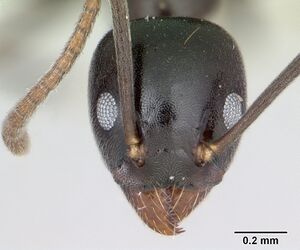   
| |
| Worker. Specimen code casent0499794. Photographer April Nobile, uploaded by California Academy of Sciences. | Owned by CAS, San Francisco, CA, USA. |
 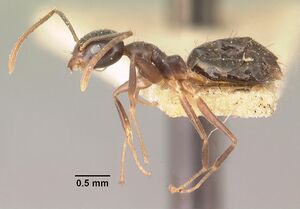  
| |
| Syntype of Technomyrmex mayri. Worker. Specimen code casent0101926. Photographer April Nobile, uploaded by California Academy of Sciences. | Owned by MHNG, Geneva, Switzerland. |
Queen
Images from AntWeb
   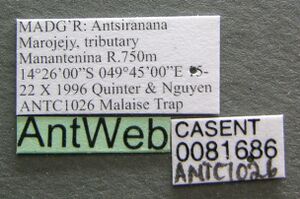
| |
| Queen (alate/dealate). Specimen code casent0081686. Photographer April Nobile, uploaded by California Academy of Sciences. | Owned by CAS, San Francisco, CA, USA. |
   
| |
| Queen (ergatoid). Specimen code casent0497537. Photographer April Nobile, uploaded by California Academy of Sciences. | Owned by CAS, San Francisco, CA, USA. |
Male
Images from AntWeb
   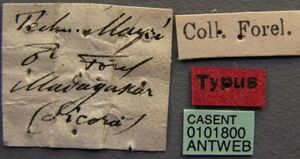
| |
| Male (alate). Specimen code casent0101800. Photographer April Nobile, uploaded by California Academy of Sciences. | Owned by MHNG, Geneva, Switzerland. |
     
| |
| Male (alate). Specimen code casent0095779. Photographer April Nobile, uploaded by California Academy of Sciences. | Owned by CAS, San Francisco, CA, USA. |
  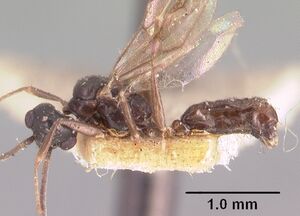   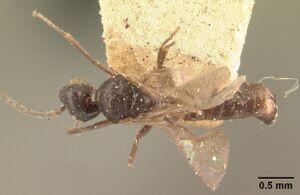 
| |
| Male (alate). Specimen code casent0101576. Photographer April Nobile, uploaded by California Academy of Sciences. | Owned by MHNG, Geneva, Switzerland. |
Nomenclature
The following information is derived from Barry Bolton's Online Catalogue of the Ants of the World.
- mayri. Technomyrmex mayri Forel, 1891b: 99, pl. 3, fig. 6 (w.m.) MADAGASCAR. See also: Bolton, 2007a: 55.
Unless otherwise noted the text for the remainder of this section is reported from the publication that includes the original description.
Description
Worker
Bolton (2007) - TL 2.7 - 4.0, HL 0.66 - 0.84, HW 0.60 - 0.79, SL 0.68 - 0.87, PW 0.38 - 0.52, WL 0.84 1.20 (25 measured). Indices: CI 91 - 95. SI 108 - 116, OI 23 - 26, EPI 72 - 82, DTI 132 - 154.
Frontal carina with 2 setae: first above the torulus, second at the level of the anterior margin of the eye. Dorsum of head posterior to this with a single pair of setae, in profile located about half way between level of posterior margin of eye and posterior margin of the head, not at the posterior margin. Anterior clypeal margin with a small median concavity; posterior margin of head shallowly concave in full-face view and the sides convex. Eyes located in front of midlength, EPI < 90; outer margin of eye fails to break the outline of the side. Number of setal pairs on mesosoma: pronotum 1; mesonotum 0; propodeal dorsum 0; lateral margins of propodeal declivity usually 1, rarely 2, the setae arising directly behind or slightly below the level of the spiracle; without setae that arise from the margin above the level of the spiracle. With mesosoma in profile the mesonotal outline forms a long shallow slope, without a distinct step or angle in the outline that defines conspicuous dorsal and declivitous faces. Dorsum of propodeum relatively long in profile and meeting the declivity in a blunt angle; straight-line length of dorsum is at least equal to depth of declivity to spiracle. The spiracle itself is anterior to the margin of the declivity, not at the margin. In dorsal view the metathoracic spiracles do not abut the metanotal groove. Gastral tergites 1 - 4 each with setae present; maximum length of setae on first gastral tergite is usually slightly less than the maximum diameter of the eye but sometimes the two are subequal. Head, mesosoma, petiole and gaster dark brown to blackish brown. Coxae, femora and tibiae the same colour as the mesosoma or slightly lighter. Tarsi of middle and hind legs dull brownish yellow to dull yellow, paler than the tibiae.
Type Material
Bolton (2007) - Syntypeworker and male, Madagascar: 30 mi. NW of Tamatave, 2S.1X.1889 (O'Swald) (Zoologisches Institut und Zoologisches Museum der Universität Hamburg) [examined by B. L. Fisher].
References
- Bolton, B. 2007. Taxonomy of the dolichoderine ant genus Technomyrmex Mayr (Hymenoptera: Formicidae) based on the worker caste. Contributions of the American Entomological Institute. 35(1):1-149.
- Cantone S. 2018. Winged Ants, The queen. Dichotomous key to genera of winged female ants in the World. The Wings of Ants: morphological and systematic relationships (self-published).
- Forel, A. 1891c. Les Formicides. [part]. In: Grandidier, A. Histoire physique, naturelle, et politique de Madagascar. Volume XX. Histoire naturelle des Hyménoptères. Deuxième partie (28e fascicule). Paris: Hachette et Cie, v + 237 pp. (page 99, pl. 3, fig. 6 worker, male described)
References based on Global Ant Biodiversity Informatics
- Bolton B. 2007. Taxonomy of the dolichoderine ant genus Technomyrmex Mayr (Hymenoptera: Formicidae) based on the worker caste. Contributions of the American Entomological Institute 35(1): 1-150.
- Bolton, B. "Taxonomy of the dolichoderine ant genus Technomyrmex Mayr (Hymenoptera: Formicidae) based on the worker caste." Contributions of the American Entomological Institute 35, no. 1 (2007): 1-149.
- Dorow, Wolfgang H. O. 1995. Review and Bibliography of the ants of the Seychelles (Hymenoptera: Formicidae). J. Afr. Zool. 110:73-96
- Dorow, Wolfgang H.O. 1996. Review and bibliography of the ants of the Seychelles. Journal of African Zoology 110(2): 73-95.
- Emery C. 1913. Hymenoptera. Fam. Formicidae. Subfam. Dolichoderinae. Genera Insectorum 137: 1-50.
- Fisher B. L. 1997. Biogeography and ecology of the ant fauna of Madagascar (Hymenoptera: Formicidae). Journal of Natural History 31: 269-302.
- Fisher B. L. 2003. Formicidae, ants. Pp. 811-819 in: Goodman, S. M.; Benstead, J. P. (eds.) 2003. The natural history of Madagascar. Chicago: University of Chicago Press, xxi + 1709 pp.
- Wheeler W. M. 1922. Ants of the American Museum Congo expedition. A contribution to the myrmecology of Africa. IX. A synonymic list of the ants of the Malagasy region. Bulletin of the American Museum of Natural History 45: 1005-1055

